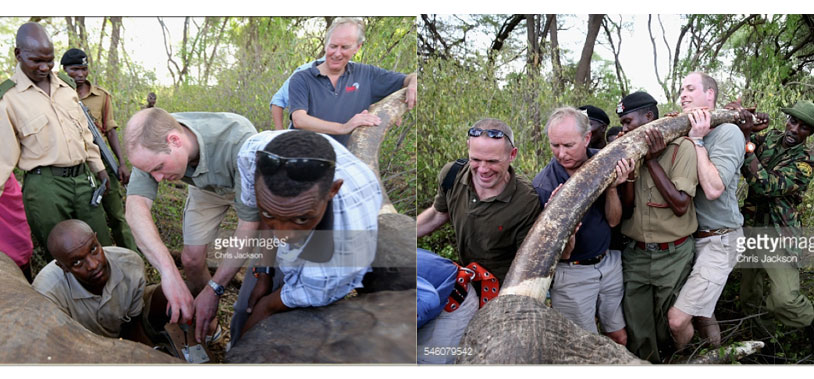Born around 1971, Matt has been known to Save the Elephants (STE) researchers since the early years of our Samburu Elephant project. Back then he was among the youngest of the mature bulls. Today he is one of the oldest and largest elephants left in Northern Kenya. Easy to distinguish from other elephants, Matt’s size and spectacular, long tusks – one broken, the other long and thick curving inward – is unmatched.
STE first started tracking Matt with a collar in 2002.Back then he was smaller, of course, but his tusks were already impressive we thought that he might turn out to be an interesting bull to study and monitor. Matt is no ordinary bull; his intelligence and curiosity always keep us on our toes, and he has become a master at losing his collar.
To date, we have collared Matt five times, most recently in March 2016 when the Duke of Cambridge, Prince William took part in the collaring operation. He chose to take a hands on role during the exercise, first by co-piloting the helicopter used to dart Matt and thereafter assisting the team on the ground to fit the collar and further ensure Matt’s position is recorded every hour for his protection and understanding his movements.

The Duke of Cambridge with the Head of Field Operations at Save the Elephants David Daballen on his left
Notwithstanding his skills of shredding and dropping his collars, we have collected a lot of movement data on him and know that he is a wide-ranging traveler. In fact, he has one of the biggest ranges of any of the elephants we have studied. Back in 2014, right after putting on his fourth collar, Matt walked a distance of about 300km in five days from Laikipia (in Central Kenya) to the Tana River.
In the same year, however, we also lost two massive bulls, Mountain Bull and Satao. Losing two outstanding, long-ranging bulls was disheartening and we were extremely worried about Matt’s long-term survival considering how large his tusks are. Perhaps his long distance movements have enabled him to survive or, he might have just adopted some effective strategies that have kept the poachers at bay, for now. His ability to survive and thrive in this dangerous environment speaks of his intelligence and experience as he continues to remain one of our most interesting elephants.
Matt comes into musth (a period of heightened aggression and sexual activity) in May and June every year. During this time, he typically visits the reserves to check out which females might be ready to mate. After he is done with musth, he returns to the lowlands of the Matthews Range (about 100 km north of Samburu Reserve) where he spends his days eating. Apparently, he even has a loyal gang of young bulls who follow him around to learn the best eating locations. Though food is one of the benefits of spending time with Matt, these young bulls continue to learn from his years of experience. Matt has not only shared his knowledge and wisdom but his genes, which we trust, will continue to improve the status of the elephant population across Northern Kenya.
As age is now catching up with him, Matt is now rarely covering large distances as he earlier did in his younger years and is seen to be spending more time with the younger bulls. Once in a while, you will also find him showing the younger bulls that he is still a remarkable bull who deserves respect and shouldn’t be reckoned with.

